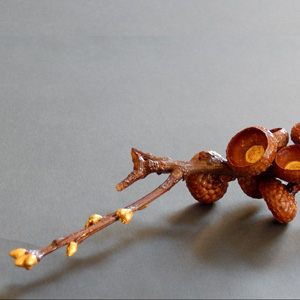Kintsugi by Karen Loomis
November 10 to December 06, 2019
Opening Reception: Sunday, November 10 from 2 p.m. to 4 p.m.
Karen Loomis Artist Statement:
Kintsugi is the Japanese art of repairing broken pottery with lacquer dusted or mixed with powdered gold, silver, or platinum. This act of embracing the flawed or imperfect, is also a Zen Buddhist philosophy, a golden alchemy that transforms the object into something new, more rare and beautiful than before by having had it's story heard. There is no attempt to disguise the damage, but to make the fault lines beautiful and strong. This offers us a metaphor for recovery from trauma, as it is a physical manifestation expressing the resilience of nature.
I first learned about Kintsugi while visiting a museum in Vienna with a friend a few years ago. “Kintsugi”, also called “kintsukuori “, means “golden seams” or “golden repair”. It is a traditional Japanese art form and “wabi-sabi” (the act of embracing the flawed or imperfect) technique of mending broken pottery which uses lacquer and gold or other precious metals to emphasize rather than hide the breaks. This technique often references natural forms such as landscapes, trees, waterfalls and rivers. Kintsugi is also a Zen Buddhist philosophy, a golden alchemy that transforms the object into something new, more rare and beautiful than before by having it's story heard. The careful repair of these broken pots symbolizes and implies a reconciliation with what is broken, imperfect and scarred. There is no attempt to disguise the damage, but to make the fault lines beautiful and strong. This offers us a metaphor for recovery from trauma, as it is a physical manifestation expressing the resilience of nature.
Healing and repairing our wounds enables us to become higher spiritual beings. I chose to express this concept in a non-traditional way, by expanding it to include not only broken pots but all of nature, especially trees. In these sculptural pieces I call attention to the lines and patterns made by time, the elements, experience, trauma, and even insects. The inspiration for these pieces first came about by mindfully stacking firewood. I became aware of the beautiful sculptural forms and shapes of the knots, holes and scars and I carefully set these aside so they would escape ignition in the woodstove. I had them around for years, and the more I looked at them, the more their stories emerged. I softened their hard edges and found the places where they needed mending. I searched the woods for their brothers and sisters, and brought home what I could carry. I wanted to put gold in the holes and around the scars. At this point I had never heard of “Kintsugi”, and when I saw those pots in the museum years later it all clicked into place and I knew what I had been doing was called Kintsugi. That provided me with the spark needed to push me further down the rabbit hole, and start investigating and observing how nature heals her wounds. The paintings and prints are an exploration into the world of patterns found in nature that emerge to re-create structure, form, and stability. I experimented with cellular, dendritic, and crystalline formations in this work. In an age where youth, perfection and novelty are worshiped, the art of Kintsugi is as applicable to our modern lives as it is to a broken bowl. The care and love expended on mending things should lead us to recognize, respect and value what is damaged and scarred, vulnerable and imperfect, in ourselves, each other, and especially on our planet.
Hampden Gallery
Recent Exhibitions
More Information
Hampden Gallery Hours:
Hampden Pop-up Gallery hours:
Monday: 1:30 p.m. - 6:00 p.m.
Tuesday:1:30 p.m. - 6:00 p.m.
Wednesday: 4:30 p.m. - 7:00 p.m.
Thursday: 12:00 p.m. - 6:00 p.m.
Friday: 12:00 p.m. - 6:00 p.m.
*Follows the University's holiday schedule
Contact Information:
Main Number: (413) 545-0680
Gallery Director, Anne LaPrade Seuthe
Gallery Manager, Sally Curcio






